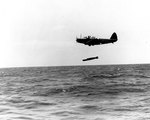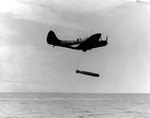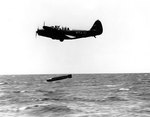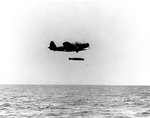Mark XIII Torpedo
| Country of Origin | United States |
| Type | Torpedo |
| Diameter | 571.500 mm |
| Length | 4.191 m |
| Ammunition Weight | 1005.00 kg |
| Range | 3.657 km |
| Machinery | Wet-heater steam turbine |
| Explosive Charge | 603 lbs. TNT or 606 lbs. TPX or 600 lbs. HBX |
| Speed | 62.00 km/h |
Contributor: David Stubblebine
ww2dbaseDesign work on the Mark XIII aerial torpedo began in 1925 but progressed in sputters and spurts because of the fluctuating attitudes of Navy planners toward the use of aerial torpedoes. So strong were the feelings that aerial torpedoes had been replaced by dive-bombing that the United States' first purpose-built aircraft carrier, USS Ranger, was designed without any torpedo storage spaces or torpedo elevators. When the thinking about aerial torpedoes swung the other way, design work and testing resumed and the Mark XIII was accepted by the Navy in 1938.Initial performance was unreliable, however, with fewer than one-third of the torpedoes performing acceptably. The design also required a drop from about 50 feet at 110 knots making the delivery aircraft extremely vulnerable to enemy fire. Modifications to the torpedo continued but the United States waged much of WWII without a dependable aerial torpedo. Most of the bugs were worked out by 1944 with the Mark XIII, Model 10. Fitted with a wooden shroud ring on the tail and a plywood drag ring on the nose, the Model 10 could be dropped effectively from 2,400 feet at 410 knots, though these extremes were not recommended. The Model 10 made it into full front-line service by the fall of 1944 and from that time onward, they received consistently favorable ratings from the torpedo squadrons in the western Pacific.
Although designed and intended strictly as an aerial torpedo, the Mark XIII was also used on certain modified PT Boats. As an aerial torpedo, PT Boats could launch the Mark XIII by simply dropping it over the side. This allowed the boats to remove their heavy torpedo tubes and replace that weight with more machine gun and cannon mounts. The Mark XIII could not be used on any class of submarine, however, because the aerial torpedo's diameter was larger than submarine torpedo tubes.
By the end of the war, dependability and performance had improved so much that the US Navy considered the Mark XIII to be the best aerial torpedo of the war and it remained in service until 1951. The Mark XIII torpedo was last used during the Korean War on 1 May 1951 when they were launched against the sluice gates at the Hwachon Dam on the Pukhan River.
In total, 16,600 examples were built.
Sources:
US Navy
Naval Weapons and Technology
Wikipedia
The Pacific War Online Encyclopedia ww2dbase
Last Major Revision: Oct 2015
Mark XIII Torpedo Mapa Interativo
Photographs
 |  |  |  |
Você gostou deste artigo ou achou este artigo útil? Se sim, considere nos apoiar no Patreon. Qualquer valor já vai ajudar! Obrigado. Por favor, ajude-nos a divulgar o site: Fique atualizado com WW2DB: |
Pesquisar WW2DB

Notícias
- » USS Orlean's Bow Found (22 jul 2025)
- » The Emperor of Japan Planned to Honor WW2-era Japanese POWs in Mongolia (4 jul 2025)
- » US State Lawmaker John Winter Caught Using Racial Slur "Jap" and Apologized (11 jun 2025)
- » Race, Holocaust, and African-American WW2 Histories Removed from the US Naval Academy Library (7 abr 2025)
- » US Government Plans to Purge WW2 Information (17 mar 2025)
- » Ver todas as notícias
Estatísticas Atuais do Site
- » 1,180 biografias
- » 337 eventos
- » 45,098 entradas na linha do tempo
- » 1,246 navios
- » 350 modelos de aeronaves
- » 207 modelos de veículos
- » 376 modelos de armas
- » 123 documentos históricos
- » 261 instalações
- » 470 eventos
- » 28,467 fotos
- » 365 mapas
Citação Famosa da 2ª GM
"Never in the field of human conflict was so much owed by so many to so few."Winston Churchill, on the RAF
Apoie-nos
Por favor, considere nos apoiar no Patreon. Mesmo R$1 por mês já faz uma grande diferença. Obrigado!
Ou, por favor, nos apoie adquirindo alguns produtos do WW2DB na TeeSpring. Obrigado!